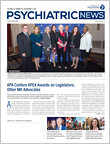While the recent report of the President’s Commission on Combating Drug Addiction and the Opioid Crisis raises the visibility of the opioid crisis, several serious barriers must be overcome to end the epidemic, according to an analysis by APA staff. The commission, led by New Jersey Gov. Chris Christie, issued the 138-page report on November 1, with 56 recommendations on how to fight the opioid crisis.
Among the greatest barriers to treating opioid addiction remain the lack of health insurance coverage and access to and availability of substance use treatment, APA noted. In 2016, close to 20 million adults needed treatment for substance use disorders (SUDs), but only 2.1 million received it, according to the National Survey on Drug Use and Health.
“The commission says it wants more treatment available and funding for it, but the administration has been trying to repeal the Affordable Care Act [ACA] and cut Medicaid, which is contradictory when many people who need treatment rely on Medicaid,” said Andrew Saxon, M.D., a professor of psychiatry at the University of Washington, director of the Center of Excellence in Substance Abuse Treatment and Education at the VA Puget Sound Health Care System, and chair of APA’s Council on Addiction Psychiatry. “The commission should be thinking about strengthening access to health care, not weakening it. This is a very expensive endeavor, and there’s no funding for it.”
Besides emphasizing the absence of new funding and insufficient treatment resources, APA staff found only limited details on the implementation of some of the commission’s recommendations.
APA strongly supports a number of recommendations in the commission’s report. Among them:
•
Improved access to treatment: The commission recommends steps to increase the use of medication-assisted treatment (MAT), including establishing a federal incentive to enhance access to MAT. Federal agencies should research promising models for pregnant and postpartum women with SUDs and their newborns. APA supports increased access to MAT; it also recommends the use of integrated care so that more people will have access to care.
•
Parity: The commission recommends that Congress grant the Department of Labor (DOL) increased authority to levy monetary penalties on insurers and employer-based plans that are self-funded and permit the DOL to investigate health insurers independently for violations of the Mental Health Parity and Addiction Equity Act. APA recommends enforcing the parity law with a standardized parity compliance tool to ensure health plans do not impose less favorable limits on treatment for mental illness and SUDs than on other medical conditions.
•
Media campaign: The commission recommends that the Trump administration fund and collaborate with private-sector and nonprofit partners to design and implement a national media campaign addressing the hazards of substance use, the dangers of opioids, and stigma.
APA recommends addressing stigma with a national prevention strategy, including a public awareness campaign, to educate the public and health care professionals about addiction as a chronic brain disease that can be effectively treated with evidence-based interventions.
“A component of the public awareness campaign should be that medication is the primary treatment for opioid use disorder and other therapies are adjuncts. Only a minority of those receiving care are getting medication. Proper dosing is very important, and the lack of success could be from inadequate treatment,” said Saxon.
•
Reimbursement: The commission and APA recommend improving reimbursement rates to health care professionals to better cover the true costs of providing SUD treatment. The commission also recommends that federal agencies revise regulations and reimbursement policies to allow for SUD treatment via telemedicine.
•
Drug courts: The commission recommends that the Department of Justice (DOJ) broadly establish federal drug courts within the federal district court system in all federal judicial districts. Those with an SUD who violate probation terms should be diverted into drug courts rather than incarcerated. The commission recommends that the National Institute on Corrections, the Bureau of Justice Assistance, the Substance Abuse and Mental Health Services Administration, and other national, state, local, and tribal stakeholders use MAT with pretrial detainees and continue treatment on release.
APA recommends that drug courts, driving-while-intoxicated courts, and veterans courts should be available to those who qualify and include high-quality, culturally competent, and gender-relevant evaluation, treatment, and monitoring for adults and juveniles.
•
Improved access to naloxone: The commission recommends that states, if necessary, make statutory or regulatory changes to allow emergency medical technicians to administer naloxone, including in higher doses, in response to the rising number of fentanyl overdoses. APA supports improved access to naloxone.
•
Research: The commission recommends that the relevant federal agencies review existing research programs on the prevention and treatment of pain management and addiction. APA supports increasing funding for research.
The commission recommends that Congress and the federal government provide additional resources to the National Institute on Drug Abuse (NIDA), National Institute of Mental Health, and National Institute on Alcohol Abuse and Alcoholism for research. NIDA should continue research in concert with the pharmaceutical industry to develop and test innovative medications for the treatment of SUDs and OUDs. APA supports increased funding in research.
•
Raising the buprenorphine treatment limit: The commission recommends removing reimbursement and policy barriers to SUD treatment, including those, such as patient limits, that limit access to MAT and other evidence-based treatment modalities.
APA disagrees with the commission ’s recommendation of removing the cap on the number of patients who can be treated by providers who can prescribe or dispense buprenorphine as this could lead to quality and diversion issues. ■
The report of the President’s Commission on Combating Drug Addiction and the Opioid Crisis can be accessed
here. APA’s comments are available
here.

